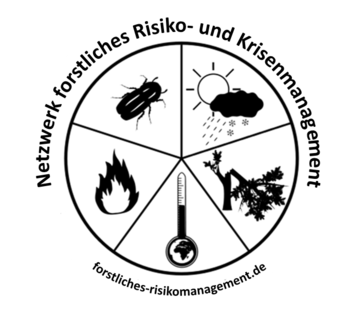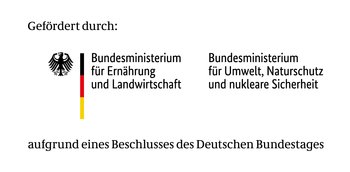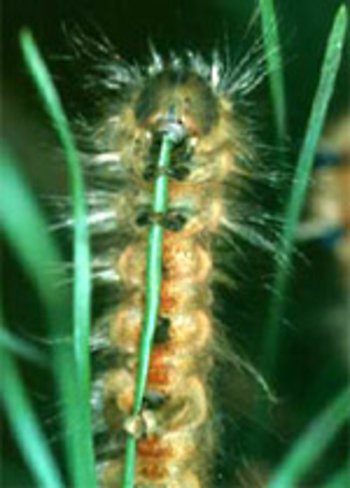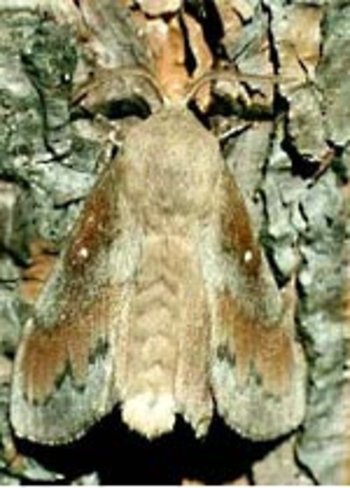In the monitoring of forests, it has been found that certain insect species become a problem through large-scale or regional propagation; thus, appropriate measures to protect the forest are taken. There is also the "poisonous stick" which is always a last resort.
Much more should be done through the application of methods of integrated forest protection and the minimal application of agricultural pesticides. Within the parameters of many forest laws and other regulations, for example the near-natural or natural forest management, or even certification guidelines, primarily chemical treatments are not normally used. For example special bark beetles help to achieve a faster and more efficient cull and removal of diseased trees. Should the above not be possible, then it is possible to remove the bark from fallen trees so that the bark beetles cannot lay their eggs there.
Founding principles of integrated forest protection
|
In the monitoring framework it can be established that the natural opponents of insect pests, for example, Tachinid flies develop quickly and able to intervene in the sense that the defence measures of insect pests can be entirely disregarded, if need be.
If these non-chemical measures are not possible or, as the case may be, successful and the threat potential still exists, then after careful appraisal processes, pesticides, in accordance with the code of integrated forest & plant protection, can also be used.
The intensity of the monitoring is related to the particular gradation of a single insect species. The effort of monitoring is increased from the latent phase to over the progradation phase to the end of the gradation. Defence measures can then be used at a local or a regional level, should the situation call for it.
A defence measure against an existing threat posed by Feeding Moth Caterpillars and in particular, so-called Pine Tree Pests (Pine Tree Lappets, The Pine Looper, The Nun Moth, The Pine Beauty and Conifer Sawflies) and also by The Oak Processionary, is the reasonable application of aerial insecticides
For an appropriate defence measure there are a multitude of legal and functional interests to observe. In forestry, licensed instruments may only be used in accordance with the plant protection laws and Ordinance on Plant Protection (Austria).
The actual licensed pesticides are published on the internet. Information for Germany and Austria can be found under 'Downloads' and 'Links'.
A close cooperation of forest, planet protection, nature protection, health and water protection authorities with the inclusion of forest managers with a commitment to plant protection tools is indispensible. The corresponding provisions to particular dosage and application of particular tools must be observed carefully when applying them. Below, you can find links to articles, where information for defence against different pests in the most important forest tree species is included.
Insecticides
Integrated Forest Protection
Insects of Deciduous and Coniferous Trees
Insects of Spruce and Fir Trees
- About the Biology of the Eight-Toothed Spruce Bark Beetle Species
- Prevention and Control of Bark Boring Insects
- Prevention and Control of Wood Boring Insects
- Der "Käfersommer"Das ABC der Borkenkäferbekämpfung
- Leitfaden der Borkenkäferbekämpfung (BFW Österreich)
- LWF-Merkblatt Nr. 14 - Rindenbrütende Borkenkäfer an Fichte
- Der Kupferstecher wird oft unterschätzt!
- Erz- und Brackwespen, Gegenspieler des Buchdruckers
- Parasitoide des Buchdruckers
- Zeit nutzen zur Borkenkäferbekämpfung
- Die Tannen-Rindennekrose: Eine ernste Gefahr für die Weißtanne
- LWF-Merkblatt Nr. 9 - Kleine Fichtenblattwespe
- Bekämpfungsmaßnahmen gegen den Großen Braunen Rüsselkäfer
Insects of Pine, Larch and Douglas Fir Trees
- Der Kiefernspinner
- Die Kiefern- oder Forleule
- Forstinsekten in bayerischen Kiefernwäldern
- Die Gemeine Kiefernbuschhornblattwespe
- Kiefernschäden durch Heidelbeerspanner
- Merkblatt: Rindenbrütende Käfer an Föhren
- Merkblatt: Der Grosse Lärchenborkenkäfer – Biologie, Überwachung und forstliche Maßnahmen
- Bekämpfungsmaßnahmen gegen den Großen Braunen Rüsselkäfer
Insects of Oak Trees
Insects of Beech Trees
Insects of Ash Trees
Ash trees are generally little more threatened by insects. Increasingly, however, ash tree death has come into focus for forest owners. Therefore, we provide here some information about the situation.
Insects of other Hardwood Trees
Insects of Maple Trees
Insects of Elm Trees
Forest Crises Management Advisory Guide
Back to the main page of the Forestry Crisis Management Advisor Guide: Overview of the different topic collections
Back to the article overview in the: The Insect Pest Topic Collection: Prevention – Identification – Action




